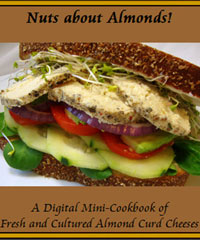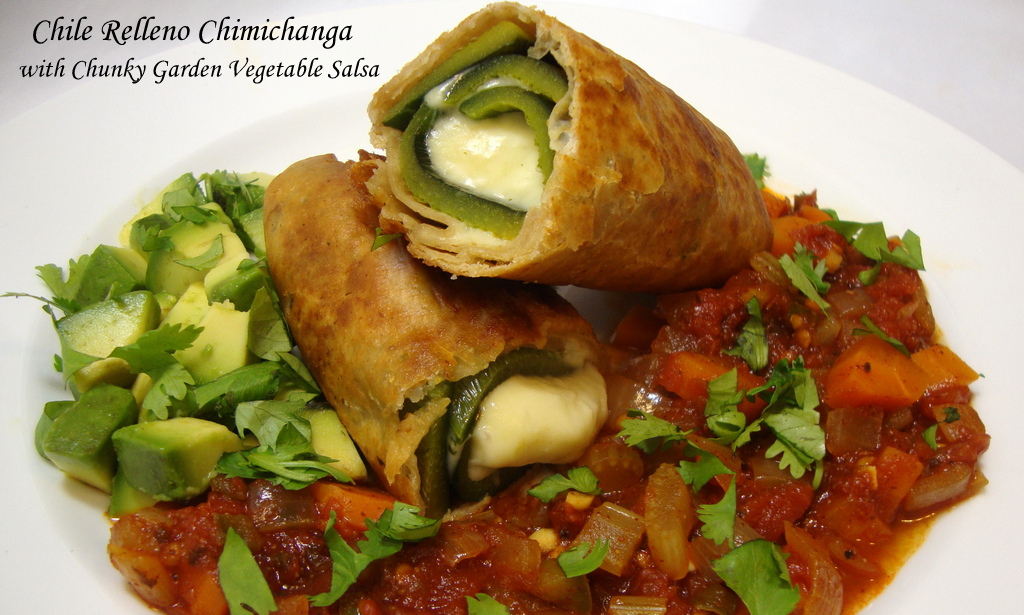 This dish is an original creation and is based upon the classic Chile Relleno; but rather than stuff the Poblano or Anaheim peppers with cheese and then batter them, the peppers are roasted and wrapped in soft tortillas with melted non-dairy Monterey Jack and flash-fried in a small amount of cooking oil (rather than deep-frying in a large amount of oil). The results are delicious and so much less greasy than the traditional dish. I chose the cheese melt over shredded block cheese since the chimichanga is flash-fried very quickly, which wouldn’t give the shredded cheese enough time to melt. The cheese melt is quick and easy to make too! (recipe follows)
This dish is an original creation and is based upon the classic Chile Relleno; but rather than stuff the Poblano or Anaheim peppers with cheese and then batter them, the peppers are roasted and wrapped in soft tortillas with melted non-dairy Monterey Jack and flash-fried in a small amount of cooking oil (rather than deep-frying in a large amount of oil). The results are delicious and so much less greasy than the traditional dish. I chose the cheese melt over shredded block cheese since the chimichanga is flash-fried very quickly, which wouldn’t give the shredded cheese enough time to melt. The cheese melt is quick and easy to make too! (recipe follows)
Ingredients:
• 4 large Poblano or Anaheim chilies
• 4 whole wheat or white tortillas (burrito size)
• 1 cup Monterey Jack Melt (recipe follows)
• Chunky Garden Vegetable Salsa (recipe follows) or salsa of your choice
• toppings and garnishing of your choice, such as diced avocado or guacamole, chopped cilantro and/or non-dairy sour cream
Items needed:
• 8 toothpicks for securing
• large skillet with ¼-inch of cooking oil
Technique:
Prepare the salsa first since it requires about 45 minutes of cooking time. If using pre-prepared salsa, skip to the next step.
Roast the chilies on a hot grill or under a broiler. Turn them occasionally until the skins are blackened and charred. When the skins of the chilies have sufficiently charred and blistered, place them on a plate and cover with foil until cool. The residual heat will steam the peppers under the foil and fully cook them through. When cool, peel the skin from the chilies (they will remove easily) and blot them with a paper towel to remove any excess moisture. Cut the peppers into strips (you will need the strips of 1 pepper per tortilla); set aside.
Prepare the cheese melt according to the directions and keep warm over low heat until ready to assemble the dish.
Next, place a tortilla directly on the stove burner set to low heat. Flip after about 15 seconds and repeat as necessary until the tortilla is heated through and is soft and pliable.*
*An alternate method for heating the tortillas is to preheat the oven to 350°F. Wrap the tortillas in aluminum foil and warm them in the oven for approximately 15 minutes. The tortillas can also be wrapped in a damp towel and warmed in the microwave for about 15 seconds; or they can be misted with a spritz of water and heated briefly in a hot non-stick or cast iron skillet.
Place a tortilla on a work surface and place the pepper strips on top. Spread ¼ cup of the melted cheese over the peppers. Begin rolling the tortilla over the pepper/cheese mixture and fold in the sides as you roll (like wrapping a burrito or spring roll). Secure the seam of the tortilla with 2 toothpicks and repeat with the remaining tortillas.
Place the skillet with the oil over medium-high heat. When the oil begins to shimmer, fry the chimichangas until golden brown, turning with a pair of kitchen tongs. They will brown quickly, so turn frequently (it is advisable to only cook 1 or 2 at a time since they brown so quickly). Transfer to a plate lined with paper towels to drain. Remove the toothpicks.
To serve, place on a serving plate and garnish as desired. Serve with the salsa.
Chunky Garden Vegetable Salsa
Salsa is the Spanish word for “sauce”. This is a cooked salsa which is served hot and is wonderful for topping a variety of Tex-Mex inspired dishes such as chimichangas, burritos and Tex-Mex tofu scrambles. Despite the inclusion of fresh jalapeno pepper, the sauce is relatively mild. To spice it up add a little chipotle chili powder or minced habanero pepper, to taste.
Ingredients:
• 1 can (28 oz) whole tomatoes
• 2 T olive oil
• 1 large carrot, peeled and diced
• 1 medium onion, diced
• 2 ribs celery, diced
• 1 large jalapeno pepper, seeded and minced
• 3 cloves garlic, minced
• 2 tsp ancho chili powder or other mild chili powder
• 1 tsp dried oregano
• 1 tsp ground cumin
• sea salt or kosher salt and coarse ground black pepper, to taste
Technique:
Drain the excess juice from the tomatoes (reserve for other uses) and pulse the tomatoes in a food processor until puréed but still chunky. Set aside.
Add the oil to a cooking pot and place over medium heat. Add the carrots and sauté for a few minutes. Now add the onions, celery, jalapeno and a couple pinches of salt and sauté until the onions are translucent and the vegetables have softened, about 10 minutes. Add the garlic and continue to sauté an additional minute.
Add the tomatoes and the chili powder, cumin and oregano. Season with black pepper as desired and bring the mixture to a simmer. Cover the pot and reduce the heat to low. Cook for about 45 minutes or until the carrots are very tender, stirring occasionally. Season the salsa with salt as needed and keep warm until ready to serve.
Monterey Jack Cheese Melt
This popular, mild white cheese can be used for a variety of Spanish and Mexican inspired dishes and is excellent as a spread for grilled cheese sandwiches. This recipe yields about 1 cup of melted cheese.
Ingredients:
• ¾ cup pure soymilk
• ¼ cup mild vegetable oil
• 3 T tapioca flour
• 1 T nutritional yeast flakes
• 1 tsp raw apple cider vinegar
• ½ tsp plus a pinch of fine sea salt or kosher salt
• ⅛ tsp lactic acid powder or ½ tsp fresh lemon juice
• ¼ tsp guar gum, sodium alginate or xanthan gum
Technique:
In a small saucepan, vigorously whisk together the ingredients until smooth. Cook the mixture over medium-low heat, stirring slowly and continually with a flexible spatula.
As the mixture thickens and curdles (forms lumps), begin stirring vigorously until the curds disappear and the cheese becomes very thick, smooth and glossy. Keep warm over low heat, stirring occasionally, until ready to use. For a spreadable consistency, remove from the heat and allow the melt to thicken.
Print Recipe
Chile Relleno Chimichangas
Votes: 7
Rating: 3.86
You:
Rate this recipe!
|
|
Votes: 7
Rating: 3.86
You:
Rate this recipe!
|
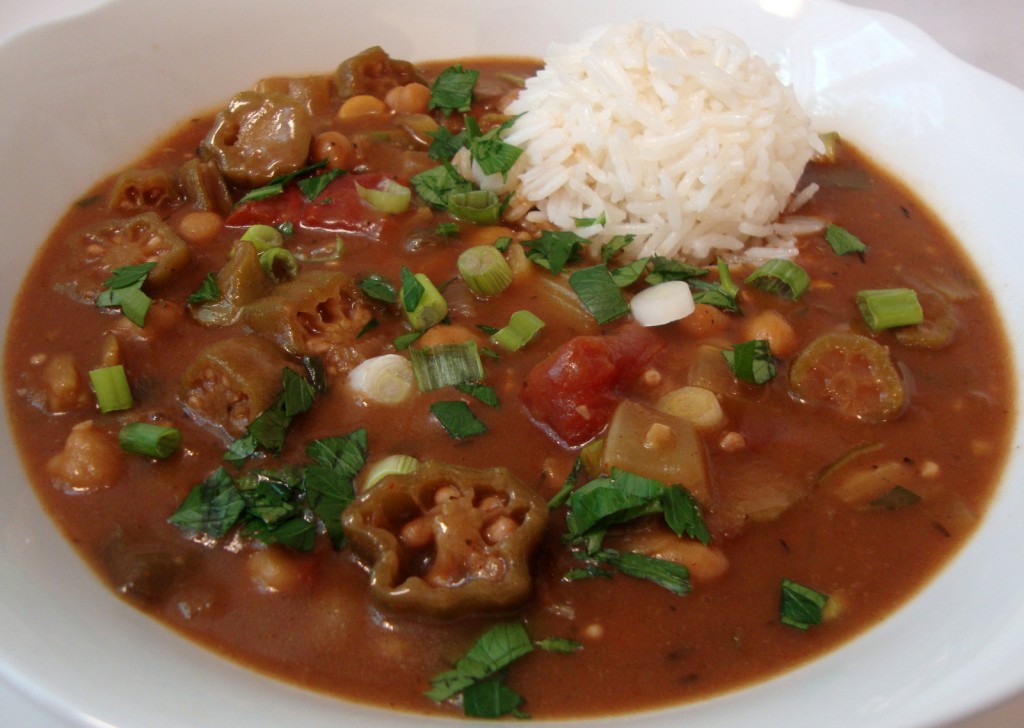 Gumbo is a heavily seasoned stew-like dish that originated in southern Louisiana from the Louisiana Creole people during the 18th century. The dish combines ingredients and culinary practices of several cultures, including West African, French, Spanish, German, and Choctaw. Creole Gumbo interacts between all class barriers and ethnicities in the south especially in New Orleans, appearing on the tables of the poor as well as the wealthy. Gumbo traditionally contains spicy meat sausage, chicken and seafood; however for my plant-based version, all meat proteins were replaced with nutritious and satisfying chickpeas. Kelp powder can be added to impart a subtle seafood taste, if desired. Gumbo is traditionally served with rice.
Gumbo is a heavily seasoned stew-like dish that originated in southern Louisiana from the Louisiana Creole people during the 18th century. The dish combines ingredients and culinary practices of several cultures, including West African, French, Spanish, German, and Choctaw. Creole Gumbo interacts between all class barriers and ethnicities in the south especially in New Orleans, appearing on the tables of the poor as well as the wealthy. Gumbo traditionally contains spicy meat sausage, chicken and seafood; however for my plant-based version, all meat proteins were replaced with nutritious and satisfying chickpeas. Kelp powder can be added to impart a subtle seafood taste, if desired. Gumbo is traditionally served with rice.
Note: Gumbo filé, which is dried and ground sassafras leaves, is an ingredient sometimes added to gumbo (but I did not include in this recipe). It imparts an earthy flavor and is also used to thicken the gumbo. After consulting a chef colleague from New Orleans who specializes in Cajun cuisine, she informed me that the filé is purely an optional ingredient. In restaurants it is often contained in a shaker on the table which gives the diner the option to use it as desired. For the cook, filé can provide thickening when okra is not in season.
Ingredients:
• ¼ cup cooking oil
• 1 large onion, chopped
• 1 green bell pepper, seeded and chopped
• 3 ribs celery, chopped
• ¼ cup vegan butter or margarine
• ½ cup all-purpose flour (or rice flour for gluten-free)
• 8 cloves garlic, minced
• 4 cups water
• ⅓ cup tamari, soy sauce or Bragg Liquid Aminos
(use wheat-free tamari or Bragg’s for gluten-free)
• ¼ cup vegan Worcestershire sauce
• 2 tsp browning liquid (optional; to enrich color)
• 1 tsp liquid smoke, or more to taste
• 1 can (14 to 15 oz) diced tomatoes with juice or 2 cups peeled and chopped tomatoes
• 3 cups frozen sliced okra
• 2 cans (15 oz each) chickpeas, rinsed and drained or about 3 and ½ cups cooked chickpeas
• 3 sprigs fresh thyme leaves or ½ tsp dried thyme
• 1 tsp kelp powder (optional)
• ½ tsp cayenne pepper, or more to taste
• 1 bay leaf
• sea salt or kosher salt and coarse ground black pepper to taste
• 4 green onions, chopped, white and green parts
• ½ cup chopped flat leaf parsley plus chopped leaves for garnish
Technique:
Prepare your mise en place (assemble and measure all ingredients).
Heat the oil in a large cooking pot over medium heat. Add the onion, bell pepper and celery and sauté until softened, about 10 minutes. Add the garlic and sauté an additional minute. Add the butter or margarine and stir until melted. Sprinkle in the flour, stir to combine and cook until the flour emits a nutty aroma, about 2 minutes.
Incorporate the water in increments while stirring vigorously. Stir in the tamari, Worcestershire, liquid smoke, tomatoes with liquid, okra, chickpeas, thyme, optional kelp powder, cayenne and bay leaf. Bring to a boil then reduce the heat; partially cover and simmer for a minimum of 1 hour. While the gumbo is cooking, prepare white or brown rice, your choice, and keep warm until ready to serve.
Five minutes before serving, stir the green onions and parsley into the gumbo (reserve a little for garnishing). Add salt, black pepper or additional cayenne, kelp powder and/or liquid smoke as desired to taste. To serve, place a scoop of white or brown rice into serving bowls and ladle in the gumbo. Garnish with green onions and parsley.
Print Recipe
Chickpea Creole Gumbo
Votes: 8
Rating: 3.75
You:
Rate this recipe!
|
|
Votes: 8
Rating: 3.75
You:
Rate this recipe!
|
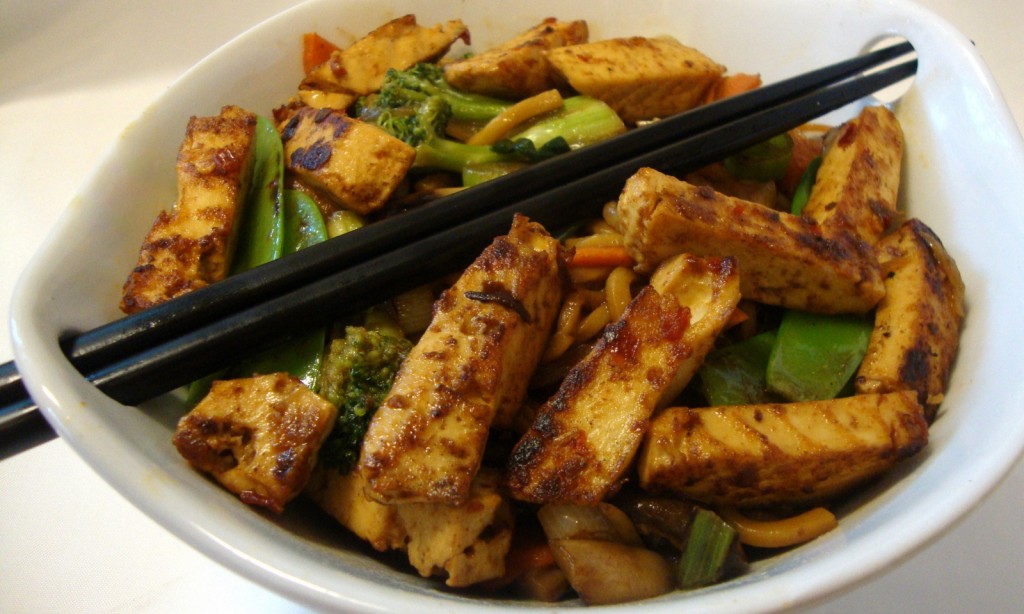
Stir Fry featuring Asian-Style Soy Chikun Strips
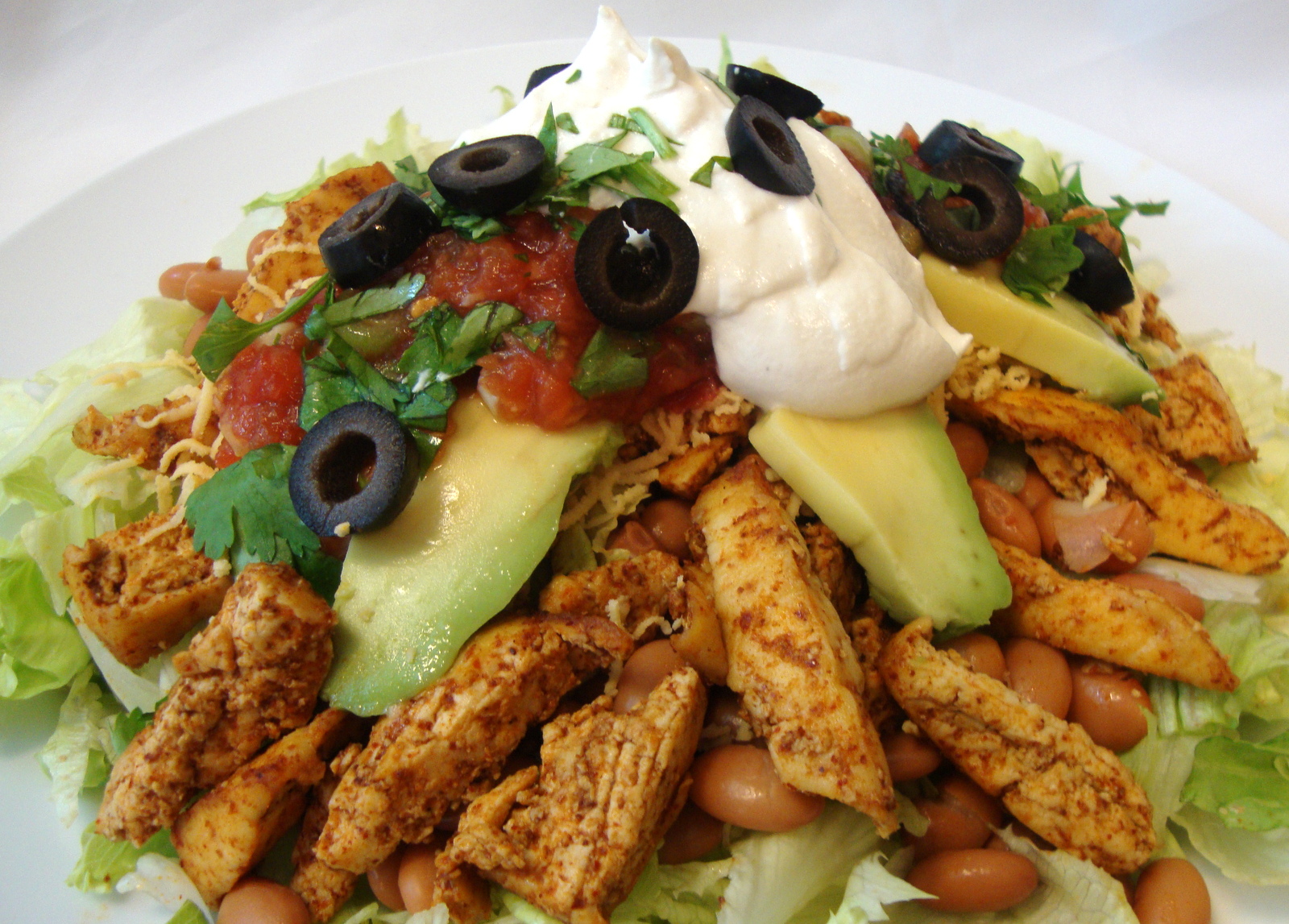
South of the Border Salad featuring Tex-Mex Soy Chikun Strips
These soy-based chikun strips are incredibly easy to make and remarkably resemble grilled strips of seasoned chicken. The ingredients are simple: tofu and a seasoning marinade. The secret is all in the preparation technique. A tofu press is recommended in order to compress the tofu properly and remove as much water as possible. However, the traditional plate and heavy weight method will work too, but the texture may not be as dense.
Each block of tofu will yield 8 ounces of prepared chikun. Most households do not possess more than 1 tofu press, so if you wish to prepare additional chikun strips, press the first block and then store in the refrigerator in an airtight container while additional blocks are pressed. For additional blocks, simply double or triple the water and seasonings in the recipe.
IMPORTANT! DO NOT use a toaster oven for baking the tofu!
Ingredients:
• 1 block (14 oz) extra-firm water-packed tofu (not silken tofu)
• ⅓ cup water
• 1 tsp nutritional yeast
• ½ tsp fine sea salt or kosher salt
• ½ tsp onion powder
• ¼ tsp poultry seasoning
• ¼ tsp garlic powder
Technique:
Press the tofu until thoroughly compressed and as much water has been removed as possible (keep stored in the refrigerator while pressing). This will take a minimum of several hours (overnight being ideal). Blot the tofu with a paper towel.
Preheat the oven to 350°F. Place a stainless steel cooking rack on a baking sheet and line with parchment paper. Place the block of tofu on the parchment paper and bake for 1 hour and 30 minutes. The tofu will develop a firm golden crust while baking. Let the block cool completely after baking.
Trim the crust from the block of tofu since it will be rather tough. Small amounts of crust may remain – that’s okay. For chikun strips, simply slice the tofu into strips. For shredded chikun, use the tines of a fork to tear off bite-size pieces. Place the strips or shreds into a zip-lock bag.
Now, in a small bowl, whisk together the remaining ingredients. The dry seasoning powders may take a moment to dissolve, so keep whisking until blended. Pour the seasoning marinade over the tofu in the bag. Press as much air out of the bag as possible; seal and refrigerate for several hours (overnight is best).
Note: Other herbs and spices can be added to the marinade to accommodate specific ethnic food flavors.
For a Tex-Mex variation, prepare the marinade with the basic recipe and add 1 tsp mild chili powder, an additional ½ tsp onion powder, ½ tsp ground cumin, an additional ¼ tsp garlic powder and ¼ tsp chipotle chili powder.
For an Asian Stir Fry variation, marinate and sauté the chikun as directed and add a dash or two of tamari while sautéing. Toss with a tablespoon of chili garlic sauce just before removing from the skillet.
For a Mediterranean variation, prepare the marinade with the basic recipe but reduce the water to ¼ cup. Add 1 T lemon juice, 1 tsp dried basil, 1 tsp dried oregano, an additional ½ tsp onion powder and an additional ¼ tsp garlic powder. Finish with fresh ground black pepper.
The strips or shreds are now ready to be pan-grilled or sautéed. This step is necessary to prepare the chikun for serving or using in recipes. Lightly oil a non-stick skillet with cooking oil and place over medium heat. Add the chikun including any residual marinade.
Sauté until the excess liquid has evaporated and the chikun is golden. Use a gentle touch while sautéing; the chikun is firm but can break apart excessively if stirred roughly. Use immediately in your favorite hot recipe or chill for use in cold recipes (wraps, salads, etc.) For soups, add the chikun the last 10 to 15 minutes of cooking time to avoid becoming too soft.
Store any leftovers in an airtight container in the refrigerator. Use within 5 days or freeze up to 1 month.
Print Recipe
Seasoned Tofu Chikun Strips
Votes: 2
Rating: 2
You:
Rate this recipe!
|
|
Votes: 2
Rating: 2
You:
Rate this recipe!
|
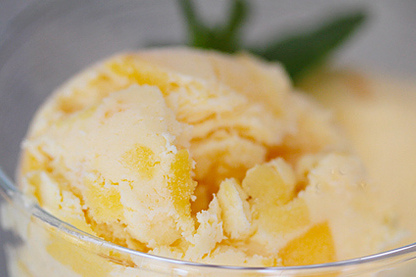
Heavy cashew cream and puréed fruit form the base for this delightful frozen treat. An ice cream maker is required for this recipe.
Ingredients:
• 1 cup (5 oz. by weight) whole raw cashews
• 2 cups non-dairy milk of your choice
• ¾ cup organic sugar
• ½ tsp guar gum
• 2 cups chilled fruit purée, smooth or semi-chunky
Technique:
Place the cashews and milk into a container with a lid, seal and place in the refrigerator to soak for a minimum of 8 hours. After soaking, place the ingredients in a high-powered blender and process on high speed for 2 full minutes.
The cream will now need to be strained to remove the solids. To do this, wash your hands thoroughly and pour the cream into the nut milk bag over a large bowl or pitcher.
While holding the top of the bag with one hand, gently knead the bag to help the cream pass through the ultra-fine mesh – avoid forcing the cream through. Discard or compost the solids in the bag.
Optionally, the cream can be poured (in increments) into a strainer lined with 4 layers of cheesecloth. Stir the cream gently with a spoon to help it pass through the cheesecloth.
Pour the heavy cream into a blender and add the sugar and guar gum; process until smooth. Pour the mixture into a container and refrigerate until very cold (or place in the freezer for about 30 minutes).
When well chilled, pour the cream mixture into your ice cream maker and add the chilled fruit purée. Process the mixture according to your ice cream maker’s instructions.
Print Recipe
Fresh Fruit Ice Cream (Cashew Cream Base)
Votes: 2
Rating: 5
You:
Rate this recipe!
|
|
Votes: 2
Rating: 5
You:
Rate this recipe!
|
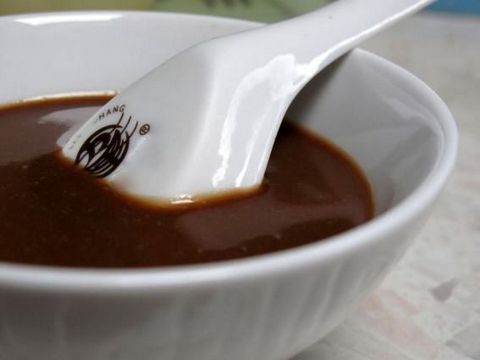
Hoisin is a thick, aromatic condiment sauce with a salty and sweet flavor. It is commonly used in Chinese cuisine as a grilling glaze (superb for seitan, tempeh and tofu); as an addition to stir fries; or as dipping sauce (try it with spring rolls). It is also used as a condiment for phở, the classic Vietnamese soup. My homemade variation contains no added sugar, starch, gums, starches, colors or preservatives, unlike most of its commercial counterparts, since the fruit naturally sweetens and thickens the sauce. This recipe yields about 1 and ½ cup.
Ingredients:
• 1 cup dark seedless raisins
• ⅔ cup water
• ⅓ cup tamari, soy sauce or Bragg Liquid Aminos™
• 2 T rice vinegar
• 1 clove garlic, chopped
• 2 tsp sesame oil
• ¼ tsp crushed red pepper
• ¼ tsp Chinese Five Spice powder
Technique:
Add all the ingredients to a small saucepan and bring to brief boil. Remove from the heat and let the mixture cool. Add the mixture to a blender and process until smooth, about 1 minute. Press through a fine mesh sieve back into the saucepan to catch any stray particles. Transfer to a sealable container and store in the refrigerator until ready to use; the sauce will thicken as it chills. Due to its salt and vinegar content, the sauce should remain preserved and fresh for a few weeks.
Print Recipe
Chef's Best Hoisin Sauce
Votes: 0
Rating: 0
You:
Rate this recipe!
|
|
Votes: 0
Rating: 0
You:
Rate this recipe!
|
 This dish is an original creation and is based upon the classic Chile Relleno; but rather than stuff the Poblano or Anaheim peppers with cheese and then batter them, the peppers are roasted and wrapped in soft tortillas with melted non-dairy Monterey Jack and flash-fried in a small amount of cooking oil (rather than deep-frying in a large amount of oil). The results are delicious and so much less greasy than the traditional dish. I chose the cheese melt over shredded block cheese since the chimichanga is flash-fried very quickly, which wouldn’t give the shredded cheese enough time to melt. The cheese melt is quick and easy to make too! (recipe follows)
This dish is an original creation and is based upon the classic Chile Relleno; but rather than stuff the Poblano or Anaheim peppers with cheese and then batter them, the peppers are roasted and wrapped in soft tortillas with melted non-dairy Monterey Jack and flash-fried in a small amount of cooking oil (rather than deep-frying in a large amount of oil). The results are delicious and so much less greasy than the traditional dish. I chose the cheese melt over shredded block cheese since the chimichanga is flash-fried very quickly, which wouldn’t give the shredded cheese enough time to melt. The cheese melt is quick and easy to make too! (recipe follows)













